More than any other region of France, Grand Est has been shaped by continual waves of settlement, invasion and border changes. As the name suggests, this is a large region of eastern France, fronting the entire border with Germany and Luxembourg, and significant portions of the Belgian and Swiss borders, too. It is unsurprising then that everything of the region's culture, from the architecture and languages, to the food and wine, is a pleasing mix of Gallic and Germanic. Visitors come to explore the battlefields of the Ardennes and Verdun, to quaff glasses of champagne, gobble up quiche and sauerkraut, hike or bike the Vosges, or to glide lazily down the mighty Rhine.
Cities and towns
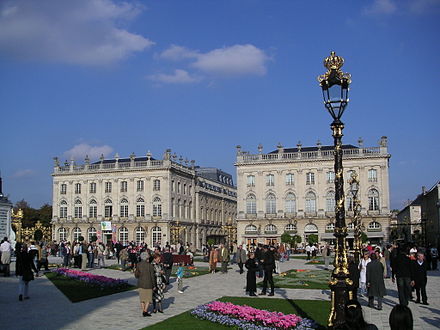

Cities
- Strasbourg 📍 — the capital of the region, home of many European institutions, as well as a beautiful UNESCO-listed city centre and miles of cycle paths and canal walks to explore.
- Colmar 📍 — small Alsatian city with many fine timber buildings and extensive pedestrianisation.
- Metz 📍 — cathedral city with a strong military history and a regional branch of the Centre Pompidou.
- Mulhouse 📍 — industrial city with an impressive array of museums, notably the Cité de l'Automobile and Cité du Train.
- Nancy 📍 — medium-sized city of culture and learning. With a large student population, Nancy hosts vibrant ballet, opera, jazz and rock scenes.
- Reims 📍 — site of the famous cathedral where the kings of France were once crowned, now heart of the Champagne region.
- Troyes 📍 — timber-frame buildings surround a Gothic monster of a cathedral, noted for its exquisite stained glass.
Towns
- Eguisheim 📍 — a circular fortified village near Colmar.
- Épernay 📍 — town known for its Champagne production, the home of Moët et Chandon.
- Épinal 📍 — local capital of the Vosges, and a former hub of the printing and textile industries.
- Husseren-les-Châteaux 📍 — a tiny village in the foothills of the Vosges, on the Alsatian wine trail.
- Kaysersberg 📍 — home to a medieval fortress and the Albert Schweitzer Museum.
- Neuf-Brisach — fortified town built in 1697. Today it is a UNESCO World Heritage Site.
- Ribeauvillé 📍 — pretty mediaeval town overlooked by the ruins of three castles, on the Alsatian wine trail.
- Riquewihr 📍 — typically Alsatian town dating from the 15th and 16th centuries, surrounded by vineyards and home to rustic local cooking.
- Sélestat 📍 — a couple of imposing sandstone churches and a humanist library make this yet another interesting Alsatian town to visit.
- Saint-Dié-des-Vosges 📍 — refreshingly-modernist architecture contrasts with the rest of the region's towns; the crowning glory is Le Corbusier's World Heritage-listed textile factory.
- Sainte-Marie-aux-Mines — mining town famous for its annual mineral and fossil fair.
- Saint-Louis
- Verdun 📍 — site of the infamous World War I battle, home to a memorial and museum. The episcopal palace is a handsome example of French Revolutionary architecture.
- Vittel 📍 — small spa town known for its mineral water and regional beauty contest Miss Lorraine.
Other destinations
- Champagne 📍 — the home of the world's most festive wine. Vineyards stretch as far as the eye can see, and the countryside is dotted with timeless villages and churches.
- Natzweiler-Struthof, 48.455°, 7.2546°. The only Nazi concentration camp in France, set up in the region of Alsace, considered by the Nazis to be part of Germany itself liberated from France, and not occupied territory. The camp had an extremely high death toll for a camp that was not intended as a death camp, due to high altitude, particularly vicious ill-treatment of inmates, and intensive pseudo-scientific human experimentation. The most notorious examples of this were the execution of over eighty Jewish prisoners, transferred from Auschwitz specifically for the purpose, to create a "historical" collection of Jewish skeletons, and experimentation with poison gases to "improve" the extermination process. 2018-10-26
Understand
 The region was created in 2016 from Alsace, Champagne-Ardenne and Lorraine, as part of national territorial reform. Compared to other merged French regions, the merger was strongly opposed by many inhabitants, as each of the old regions has its own distinct identity. People in Alsace in particular took to the streets in protest, and an Alsatian independence movement has gained significant traction.
The region was created in 2016 from Alsace, Champagne-Ardenne and Lorraine, as part of national territorial reform. Compared to other merged French regions, the merger was strongly opposed by many inhabitants, as each of the old regions has its own distinct identity. People in Alsace in particular took to the streets in protest, and an Alsatian independence movement has gained significant traction.
Throughout history, much of the area ping-ponged between Germany and France, and the last time parts of it were administered as part of Germany (by the Nazis) is still just about in living memory. The local culture is therefore a distinct blend of the two countries, though this is most pronounced in the east of the region. Despite or because of that, you get a sense that the locals, particularly in Alsace and Lorraine, are more patriotically French than anywhere else in the country. Expect to see a lot of tricolores, even outside of national holidays.
The west of the region is largely flat or softly rolling - perfect for Champagne! - while the land becomes more rugged toward the north (the Ardennes hills) and east (the Vosges mountains). Beyond the Vosges is the Rhine Valley, and the Rhine forms the natural border between France and Germany.
Talk
Slightly-accented French is the everyday language spoken by everyone, young and old. Because Germany, Luxembourg and Belgium are nearby, people in the Grand Est region speak in a more guttural manner compared to other parts of France. The government maintains that French is the only official language of the Republic and largely ignores the existence of all others, so local languages are dying out across France, though this region has one exception.
Regional languages are still spoken. Alsatian (Elsässerditsch) is a dialect closely related to Swiss German and Alemannic, still spoken in Alsace and south-eastern Lorraine. Unlike most regional languages in France, Alsatian has seen a timid yet noteworthy renaissance. Lorraine Franconian (francique or platt) is spoken mainly near the Belgian and German borders. Alsatian and Franconian are non-standardised dialects of German containing many French loan words, spoken mainly by older inhabitants in the countryside. East of the Vosges and near the German border, you'll notice many placenames are partly or fully Germanic. The rest of the region is resolutely Francophone; Champenois and Lorrain are the dialects of French spoken by some in the Champagne and Lorraine, respectively.
Other than that, English and standard German are worth a try, especially if you don't speak French. Travellers in cities and major tourist spots should have no trouble communicating without a knowledge of French, but it's always a good idea and good manners to learn a few basic phrases.
Get in
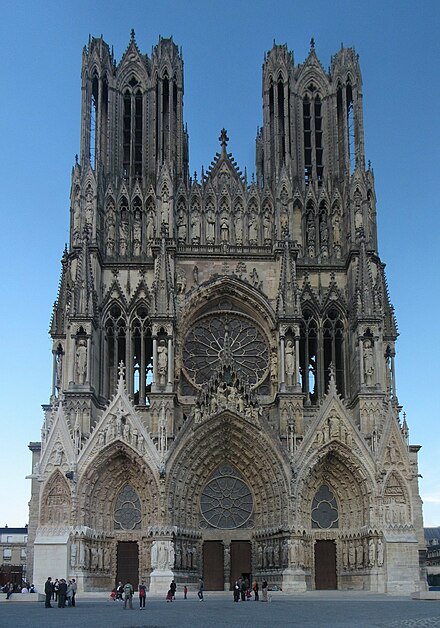
By plane
- EuroAirport (Basel-Mulhouse-Freiburg) is by far the largest international airport in the region, with connections to pretty much everywhere in Europe. There are also a couple of flights from North Africa, and a seasonal service from Montreal Trudeau, operated by Air Transat. For UK travellers, British Airways fly from London Heathrow, while easyJet fly from Bristol, Edinburgh, London Gatwick, London Luton and Manchester.
- Strasbourg Airport (IATA: SXB) receives a small range of flights from European, North African, and Turkish cities.
- Lorraine Airport (IATA: ETZ) serves a few domestic destinations, with seasonal flights to holiday destinations in the Mediterranean.
Alternatively, the TGV offers a direct connection (1-2 hours, depending on where in Grand Est your final destination is) from Paris Charles de Gaulle, France's main international airport, which receives flights from most parts of the world. Just across the border in Germany there is also Karlsruhe Baden Baden (IATA: FKB) which receives many Ryanair flights. Luxembourg Airport is a possible option if you want to visit the Lorraine region.
By train
From within France
LGV Est is the high speed line that serves the region. The TGV from Paris (Gare de l'Est) serves all the major stations of the region in under two hours. In addition to city centre stations, two TGV stations serve the rural areas in the west of the region: Champagne-Ardenne TGV 📍 (near Reims) and Meuse TGV 📍 (close to Verdun). The line also offers connections from most other parts of France, including Bordeaux, Lille, Lyon, Marseille, Poitiers and Tours). At 320 km/h, you'll be on the fastest train in Europe!
From Belgium and Luxembourg
EuroCity operates trains from Brussels (Midi / Zuid), Namur and Luxembourg to Strasbourg and Mulhouse. Meanwhile, the Luxembourg to Paris TGV stops at Metz, Meuse and Champagne-Ardenne en route. There are also a number of local cross-border services operating through the Ardennes.
From Germany
A mixture of SNCF TGVs and Deutsche Bahn ICEs operate from Frankfurt (Hauptbahnhof), Karlsruhe, Munich and Stuttgart to Strasbourg. Additional ICEs operate from Frankfurt and Saarbrucken to Lorraine TGV 📍, situated more or less equidistant between Nancy and Metz (though not especially close to either - 35 km in fact, the classic local government compromise that ends up suiting nobody). There are a number of local cross-border services as well.
From Switzerland
TGV and Intercités trains (both SNCF) operate from Zurich and Basel through Alsace, generally stopping at Mulhouse, Colmar and terminating at Strasbourg.
From the United Kingdom
Eurostar offers combined tickets from London (St Pancras), Ebbsfleet and Ashford to many cities in Grand Est, changing at Lille (Europe). While it may seem like a hassle changing trains, this service is both cheaper and quicker than you might think; for instance London to Strasbourg for as little as £50 return can be accomplished in around 5 hours. Generally, the time sails by as quickly as the countryside outside, and you get to travel city centre to city centre, without facing the questionable pleasures of a couple of airports in between.
From Eastern Europe
If you already thought Grand Est was pretty well-connected by rail, you ain't seen nothing yet! Russian Railways' Moscow to Paris service takes seeing Europe by train to another level. Passing by Minsk, Warsaw, Berlin, Hanover and Frankfurt, the train stops in Strasbourg before going on to Paris. It's a sleeper service, and from Moscow you'll spend two nights on board (to be precise, 32 hours), but presumably if you're in love with the romance of crossing a continent by train, this will appeal to you. Count on spending around €250 for a second class (4 person) berth, or €360 for a first class (2 person) berth. Departs every Wednesday from Moscow Belorussky station.
By car
The region is well-connected by road. The A4 autoroute links Paris to Reims, Metz and Strasbourg, while the A5 links the capital to Troyes and the southern half of Grand Est. The A26 links Calais and the north to Reims (270 km from Calais) and Troyes (400 km), and this route is used by so many British drivers, that the whole highway is called the Autoroute des Anglais. Motorists from Belgium will pass through Luxembourg and enter France north of Thionville on the E25, while those driving from Germany will generally take the Saarbrucken - Forbach route (E50). Pan-European roads use green route indicators alongside the French national routes' red indicators. There are any number of roads crossing all of Grand Est's foreign borders, and the vast majority will be unmanned by any sort of frontier force. The Schengen Agreement permits open borders across much of Europe, but security concerns since 2016 have caused some checks to be reinstated.
_For more detail on the region's autoroute system, see_Get around below.
Get around
By train
Apart from the TGV, which links the region's main cities, the rest of the network is slower, provided by TER Grand Est.
.jpg/440px-Cath%C3%A9drale_Saint-%C3%89tienne_de_Metz,_Metz,_Lorraine,_France_-_panoramio_(4).jpg)
By car
The region is well-connected by road, with the following motorways (autoroutes) being particularly useful:
- A4 (east-west): Île-de-France, from Paris, Reims (A26/A34), Champagne, Verdun, A31, Metz, the Vosges, A35, Strasbourg
- A5 (east-west): Île-de-France, from Paris, Troyes, A26, A31
- A26 (north-south): Hauts-de-France, from Calais, Reims (A4/A34), Champagne, Troyes, A5
- A31 (north-south): from Luxembourg, A4, Metz, Nancy, Vittel, A5, Bourgogne-Franche-Comté, to Dijon
- A34: Reims (A4/A26), Charleville-Mézières, the Ardennes, Belgium, towards Luxembourg Province
- A35: (Rhine Valley, north-south): Germany, from Karlsruhe, A4, Strasbourg, the Vosges, Colmar, Mulhouse, Switzerland, towards Basel
The majority of the region's autoroutes are operated by two private companies, so toll charges apply.
See
- Cathedrals: Grand Est has some of the most beautiful in Europe; the most notable are at Reims, Metz, Troyes and Strasbourg
- Vineyards: Champagne, Alsace and Lorraine are the major wine regions of Grand Est
- Two marvellous museums in Mulhouse: the Cité de l'Automobile and the Cité du Train are respectively France's largest car and railway museums

- Charles de Gaulle Memorial, +33 3 25 30 90 80. Closed Jan; Feb–Apr: Open 6 days a week 10:00–17:30 (closed Tu); May–Sep: Open every day 9:30–19:00; Oct–Dec: Open 6 days a week 10:00–17:30 (closed Tu). France's national memorial to its great leader and statesman is at his former home and burial place. The memorial is a gigantic patriarchal cross which dominates the surrounding countryside. Also onsite is a museum which charts General de Gaulle's life, from his role in the Allied war effort and liberation of France, to leading his country into its economic golden era and the foundation of the Fifth Republic. Adults: €13.50; concessions: €11; children (6-12): €8; children (under 6): free 2017-01-21
- Lalique Museum (Musée Lalique), Rue du Hochberg, Wingen-sur-Moder (About 2 km northwest of Wingen-sur-Moder (served by TER Alsace rail) on Rue du Hochberg (D919)), 48.9266725°, 7.32165523°. Daily 10:00-19:00 Apr-Sep & December; Tu-Sa 10:00-18:00 Feb, Mar, Oct, Nov; Closed in January. A very large collection of works by René Lalique, a renowned French glassmaker and jeweller active from the 1880s until his death in 1945. The museum is adjacent to the sole production facility operated by Lalique (the company he founded), opened in 1921 and is on the site of a glass-making factory dating to the 18th century. €6 adults; €3 children 6-18; children under 6 are free
- Reims-Gueux (Circuit de Gueux), Highway D27, Gueux (on Hwy D27 between Thillois and Gueux), 49.2541°, 3.9312°. The grandstands and other buildings for the former Reims-Gueux Grand Prix motor racing course still stand, some restored by volunteers, others fenced off for safety reasons but still impressive to view from the outside. Free, donation appreciated 2022-01-07
Do
- The Vosges — an accessible and relatively low-lying range of mountains, with the highest peak at 1,424 metres, straddles Alsace and Lorraine and forms the western border of the Rhine valley. The landscape is lush and wooded, and surprisingly wild wildlife - wolves, lynx, chamois, capercaillie - make this region perfect for anyone interested in the preservation and restoration of western Europe's native biodiversity. The main long distance hiking trail is the GR 5, while a web of mountain bike routes cover the countryside. While its slopes may not be as famous as the Alps, there are plenty of winter sports opportunities in the Vosges, centred on the resort of Markstein.
Itineraries
- Alsatian Vineyard Route — fabulous for drifting from town to town trying a whole bunch of local wines. It's very easy to slip into this relaxing pace of life and, aside from sampling wine, is also a great opportunity to soak up the landscape, admire villages, meet fellow vinophiles and locals, and eat the local fare. You can hike, cycle or drive, while bearing in mind that these activities and alcohol don't always mix. Many of the route's towns wouldn't look out of place on a chocolate box, so do take your time to linger rather than rushing to move on to the next vineyard.
- Route des Crêtes — Drive on the scenic Route of the Ridges, following a relatively elevated set (at around 1,200 m) of mountain roads for 77 km along the Vosges. Some of the roads are blocked by snow during the winter, as the road doesn't get cleared. Parts of the road are instead turned into a winter hiking trail.
- Route Romane d'Alsace — Explore a mixture of the most and least well-known Romanesque buildings in Alsace, covering both large cities and small towns.
- River Rhine — A relatively short section of this long international river marks the border between France and Germany.
Eat
See also: French cuisine
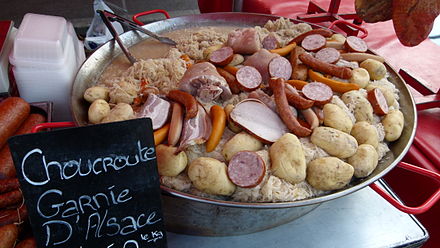
The cuisine is highly regionalised, though portions tend to be hearty and you'll notice a strong reliance on pork products throughout. Vegetarians and halal-conscious Muslims are best catered for in urban areas, while Strasbourg has a large Jewish quarter with good kosher restaurants and shops.
Alsatians share a culinary heritage with south-west Germany, so expect lots of pork and sausage sauerkraut (choucroute), flammeküche (tarte flambée - like a very thin oblong pizza) and creamy, chocolatey, cherry-filled Black Forest gateau (forêt-noire). What makes Alsace special is that these stereotypical 'German' dishes are cooked with the usual panache and savoir-faire that you'd expect from French chefs, and locals are quick to inform you, with a snort, that their sauerkraut is far superior to anything the well-meaning fools on the other side of the Rhine could come up with! One dish unique to the Alsace is baeckeoffe, a casserole with mountains of meat (pork, beef and lamb - all in one pot), potatoes and veg. Its inspiration, the hamin, can still be eaten (sans pork), in Strasbourg's Jewish restaurants during the Friday-Saturday sabbath. In large cities or touristy areas it is not particularly difficult to find vegetarian versions of traditional dishes such as flammekueche, spaetzle or baeckeoffe, although vegetarian interpretations of choucroute are pretty much non-existent.
Lorraine has one stand-out dish that has conquered the planet: quiche lorraine. The original and best recipe fills shortcrust pastry with eggs, cream and smoked bacon, and is not quite like any of the hundreds of variants and imitators you can buy anywhere in the world. Aside from this, the region's pâté, potato dishes and stews are celebrated, as are a local variety of plums - the mirabelle. The gastronomically-adventurous will dare to try some of the many saucissons and charcuteries, as well as andouille (tripe sausage) and tête de veau (calf's head). The latter two especially can seem like a gamble; if you have good reason to be confident in the chef's ability, give them a go and the scales may well fall from your eyes as you enjoy complex and subtle flavours.
The cuisine of Champagne is among the least well-known, as it is largely indistinguishable from the French mainstream. Nonetheless, you should make time for a potée champenoise - a wonderfully slow stew of ham, bacon, cabbage, beans, carrots and potatoes - and indeed anything with pieds de porc (pigs' trotters) in it. Many dishes use the local bubbly as a key ingredient: hedonists will want to luxuriate with hot oysters in champagne! This area is particularly known for its sweets - biscuits roses, macarons and chocolate champagne corks.
This being France, you mustn't overlook the cheese. The highlights (all made with cows' milk) include creamy and slightly crumbly langres, the very soft and strong munster from the mountains and carré de l'est, with the appearance of a square brie but unmistakable flavour of smoky bacon.
Drink
.jpg/440px-Vendanges_2012_en_Champagne_(Avize,_chardonnay).jpg)
In case you haven't been paying attention, around these parts wine is king! Touring the vineyards of the Champagne and Alsace are veritable rites of passage for any discerning wine buff, but even for those without the patience to go on tour, restaurants can be relied on to serve the best local vintages. Champagne is the world's best-loved (and potentially most bank-breaking) sparkling wine. Alsace is mainly known for its whites and the grape varieties are often - surprise surprise - akin to their German counterparts. Completely off the beaten track is Lorraine wine, whose notable crus include côtes de Moselle and the gris de Toul, a rosé wine that actually looks grey.
Here on the edges of northern and central Europe, the importance of beer can't be overstated. Lorraine and Alsace have the highest quality brewers: Champignolles, Kanterbräu and Grimbergen, as well as France's 'national beer' Kronenbourg. In pubs and bars, order pression (draft), while supermarkets are great for 'stocking up' on cans and bottles.
In Lorraine, there is also a tradition of making plum liqueurs and eaux de vie. Mirabelle and quetsch are the two plum varieties used to make these drinks, and production seems to be more of a cottage industry than being aimed at the mass market.
Sleep
As with most of France, accommodation options are based around hotels in town and cities, and self-catering gîtes in the countryside. In the Vosges, there are many farmhouse inns which offer an authentic rural experience. Campers and caravaners are well-catered for all over France, and Grand Est is no exception.
Stay safe
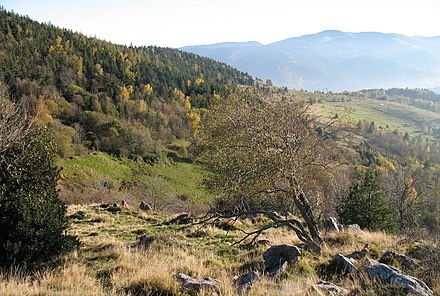
This is a predominantly rural and safe region; any issues relating to specific cities can be found in the relevant articles. Enjoy the local tipples in healthy moderation and don't get behind the wheel while under the influence. Aside from the obvious risk of death, the Gendarmerie Nationale do not take kindly to drunk drivers, and being foreign will not let you off the hook.
In wilder areas there are some animals with the potential to harm humans, notably deer, boar and wolves. Male deer (stags / bucks) should be avoided during the autumn rut (mating season), while in the spring, it is inadvisable to get between a mother doe and her baby. During both of these seasons, local authorities advise walkers / cyclists to stay on the path. Boar have been known to charge humans, especially when they have piglets, though you can observe them safely from a distance. Wolves haunt many of our nightmares, but in reality pose very little threat to people unless they themselves feel threatened. They are still exceedingly rare in this part of France, and as they have keen senses and try to keep away from people, your chances of meeting one are only slightly higher than in a wolf-free area.
Also be aware that portions of Grand Est's countryside are part of the Red Zone (Zone Rouge), having never recovered from World War I. Look out for signposts and fencing around these areas as they contain unexploded ordnance such as grenades amongst other dangers such as traces of arsenic and perchlorate in the soil and water.
As with the rest of France, pickpocketing and aggravated assaults do occur, and you should be vigilant in both rural and urban areas. This is partially because the Grand Est region used to depend on heavy industries, and places such as Mulhouse, Metz, and the Ardennes region were brutally hit by deindustrialisation and the ensuing deprivation.
Go next
As you have discovered, Grand Est is big so its borders are long, and there are many neighbouring regions to explore:
Staying in France
- Bourgogne-Franche-Comté — continue your discovery of French wine in Burgundy, while sampling classic cuisine (boeuf bourguignon, coq au vin, escargots) and exploring historic Dijon. Also contains the French part of the Jura mountains.
- Hauts-de-France — the 'great north' has oodles of belfries and cathedrals, a history that is both fascinating and horrifying in equal measure, and a bracing sandy coast. Anyone for moules frites?
- Île-de-France — board a TGV and be whisked to the French capital: the Eiffel Tower is only two hours away. Seine-et-Marne (the department closest to Grand Est, before you reach Paris) contains an extension to Champagne country, as well as Disneyland and the royal hunting palace of Fontainebleau
Over the eastern border
East of the "Great East" are four great countries: Belgium, Luxembourg, Germany and Switzerland. All are part of the Schengen Area, but if you're a non-EU citizen, you're still better off bringing your passport, just in case.
- Wallonia (Belgium) — you'll feel far from the madding crowd in the Francophone part of Belgium. Hilly, forested and sparsely inhabited, it is nonetheless home to cities such as Liège, Mons and Dinant, which are overlooked by many tourists and thus considered hidden gems.
- Luxembourg — the only grand duchy in the world is also the second-smallest EU member state. Centred on the capital of the same name and home to more lovely countryside than a place its size ought to have.
- Saarland (Germany) — a product of the Treaty of Versailles, tiny Saarland was fought over by France and Germany just like Alsace and Lorraine. Great for history lovers, particularly those interested in industrial heritage and the world wars.
- Rhineland-Palatinate (Germany) — natural extension to any wine holiday, home to the scenic Middle Rhine Valley landscape of steep hills and fairytale castles, and small cities with millennia of history: Mainz, Koblenz and Trier.
- Baden-Württemberg (Germany) — Germany's south-west is bucolic and easy on the eye. The Black Forest is just over the Rhine from Alsace, and the forest's towns and villages are well-known for their mediaeval beauty. Further in, green industrial Stuttgart and romantic-academic Heidelberg welcome urban explorers.
- Switzerland — Basel's museums and characteristic trams are mere minutes from the French border, while further south will get you into the majesty of the Swiss Alps; lakes, chocolate, cuckoo clocks and any other cliché you can think of.


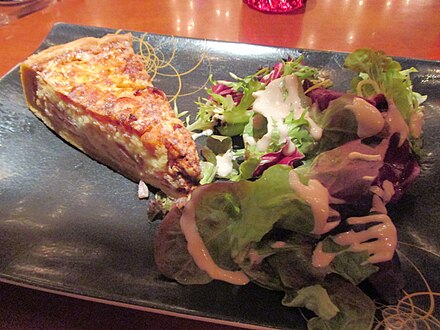
.JPG/440px-Verdun_-_porte_Saint-Paul_(1).JPG)